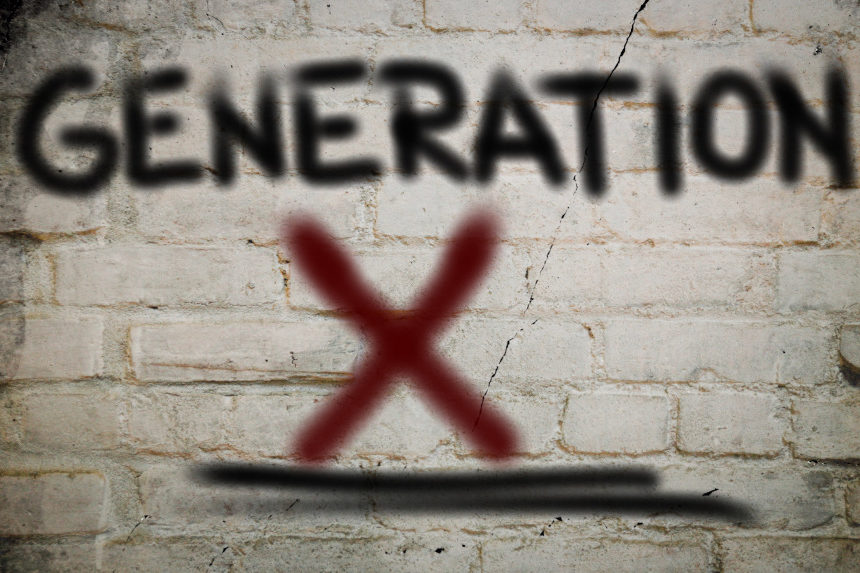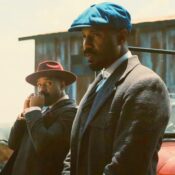When CBS News recently ran a snapshot of generational groups, they did something that no one could have guessed. Scratch that; they did something that members of one generation could have guessed. CBS left out the group known as “Generation X,” which actually didn’t surprise the people in my generation at all. In a culture that still thinks of Millennials as pre-teens (they’re presently 22-37 years old) that ruined everything, Generation X, so named because of the Douglas Coupland book and its antecedents, is used to being left out. Born between 1961 and 1981, they were the original latch-key kids and the first ones raised with video games and the loose collection of BBSes (online bulletin boards) that would become the internet. As the “MTV Generation,” they were there for the rise of hip-hop, punk, and the various branches of alternative rock.
The baby boomers, when they were younger, used to say that you shouldn’t trust anyone over 40; Generation X had a hard time trusting anybody, especially, as writer Chuck Klosterman explained, after Darth Vader turned out to be Luke’s dad. But one thing that GenX always had was the movies; as the first generation to have HBO, satellites dishes, expanded cable, and all of the various home video platforms in addition to movie theaters, films were just as important as music to the generation’s development and sense of itself.
With the 25th anniversary of the release of Reality Bites this week, we look back at some of the most significant movies (all with killer soundtracks) about what is apparently the new Forgotten Generation.
1. Reality Bites (1994; directed by Ben Stiller)
The original theatrical trailer for Reality Bites.
We’ll start here because its anniversary occasioned our piece and because Generation X learned to love the nonlinear narrative. Reality Bites has a reputation that’s only grown because it encapsulated a number of narratives that were essential to the generational experience. This one film encompasses the struggle of making art versus finding a regular job, the idea of compromising one’s ethics for work or success, the fear inherent in getting tested for HIV, the weight of coming out to one’s parents, and the realization that success may earn the contempt of one’s peers. It also delivers one of the earliest, and most lacerating, critiques of MTV and reality television.
See also: The Last Days of Disco (1998).
2. The Breakfast Club (1985; directed by John Hughes)
The original theatrical trailer for The Breakfast Club.
The Breakfast Club dove right into the social stratification present in U.S. high schools. While it wasn’t the first film to do it (Fast Times at Ridgemont High and others took this on), Club applied an almost stage-play-like ethos by picking one character to represent different ideas (brain, athlete, basket case, princess, criminal) and putting them in the bubble of daylong detention. Hughes displayed a unique sensitivity to all of the characters, making each one rise above their stereotype (we still give a thumbs-down to Ally Sheedy’s makeover, though).
See also: The aforementioned Fast Times at Ridgemont High (1982) and Hughes’ other teen classics, like Pretty in Pink (1986), Ferris Bueller’s Day Off (1986), Some Kind of Wonderful (1987), and the “wow, that wouldn’t get made today” Sixteen Candles (1984).
3. Better Off Dead (1985; directed by Savage Steve Holland)
The original theatrical trailer for Better Off Dead.
Savage Steve Holland can do it all, from animation to voice acting to writing and directing. In the mid-1980s, he made a set of three films that put an absurd, but intellectually truthful, spin on the life of GenX teens. The first, Better Off Dead, took the topic of teen romance and, shockingly, teen suicide, and made it into a farce that includes such disparate elements as a ski race, a Claymation sequence, and the much-quoted paperboy that wants his “Two dollars!” While much broader and off-the-wall than other films that directly applied to the lives of this particular audience, it still resonates as a good time.
See also: Holland’s One Crazy Summer (1986) and How I Got Into College (1989), and The Last American Virgin (1982), which also features Better Off Dead actress Diane Franklin.
4. The Lost Boys (1987; directed by Joel Schumacher)
The original theatrical trailer for The Lost Boys.
The Lost Boys does what Stephen King excels so well at — it integrates social concerns and fears along with fright. Part of the plot engine stems from the fact that brothers Sam and Michael are dealing with a move brought on by their parents’ divorce. Michael’s interest in a girl and struggle to fit in puts him with a bad crowd (in this case, vampires). Sam and his buddies, the Frog Brothers, play into the aesthetic first laid down by King in ’Salem’s Lot, and carried on in films like Fright Night and The Monster Squad, that the nerds and outsiders are frequently the best mentally equipped to deal with the supernatural. It may also contain the best final line of the ’80s.
See also: On the related teen-horror side, Fright Night (1985), The Monster Squad (1987), and ’Salem’s Lot (1978 version). On the purely GenX side, Schumacher’s St. Elmo’s Fire (1985).
5. Heathers (1989; directed by Michael Lehmann)
Trailer for Heathers.
If Better Off Dead deployed farce to deal with teen suicide, Heathers hits it with the darkest of black comedy. Shocking at the time and still controversial today, Heathers treats the high school popularity wars as a kind of bloodsport; at one point, Winona Ryder’s Veronica even writes in her diary that “My teen angst bullshit has a body count.” Christian Slater cemented his teen-star status with his malevolent performance and a plot that seemed over-the-top at the time, but is much more uncomfortably plausible now.
See also: The Doom Generation (1995).
6. Do the Right Thing (1989; directed by Spike Lee)
The original trailer for Do the Right Thing.
Spike Lee caught lightning in a bottle when he released his third feature-length film. An Academy Award-nominated work of staggering power, Do the Right Thing focuses on a single block in Brooklyn as tensions rise during the hottest day of the summer. The raw examination of racial relations served up an emotional gut-punch, with many white viewers realizing for the first time what it might be like to be young and black in America. It remains one of the most acclaimed films of its decade and frequently appears on lists of the best films of all time.
See also: Lee’s School Daze (1988) and Crooklyn (1994).
7. Slacker (1990 local/1991 wide release; directed by Richard Linklater)
The first trailer for Slacker.
Richard Linklater began his storied career with this indie gem that details a day in the life of a number of people in Austin. Many of the characters talk about big-picture social concerns, but never for very long, as Linklater’s clever approach follows people from conversation to conversation without a typical scene structure. Slacker’s low-fi technique inspired a number of other filmmakers (like Kevin Smith, later on the list). Linklater would visit this generation over and over, even following some as they aged in his Before trilogy.
See also: Linklater’s catalogue, including Dazed and Confused (1993), Suburbia (1996), Waking Life (2001), Everybody Wants Some!! (2016), and the Before trilogy (Before Sunrise, Before Sunset, and Before Midnight).
8. Pump Up the Volume (1990; directed by Allan Moyle)
The original trailer for Pump Up the Volume.
One thing that the films of the very early 1990s didn’t anticipate was how social media would reshape everything. That makes the premise of a pirate radio station almost quaint. However, Moyle’s hard gaze at the kinds of problems and alienation that afflicted GenX teens is dead-on. Christian Slater gives another dynamic performance as a painfully withdrawn student by day and a wild man behind the anonymity of his secret radio identity at night. His willingness to talk about real problems and encourage his listeners to rebel puts him in the crosshairs of educators and the law. Even today, Pump Up the Volume remains one of the few films to tackle the idea of corruption and intentional student record mismanagement that can occur in schools.
See also: Moyle’s earlier film Times Square (1980) and the radio-themed Talk Radio (1988).
9. Boyz N the Hood (1991; directed by John Singleton)
The original trailer for Boyz N the Hood.
The music of N.W.A. put a spotlight on the difficulties of life in South Central Los Angeles, so it was more than appropriate that Ice Cube would make his film debut in this story of a group of friends trying to make their way, or make it out. The concerns of Boyz (itself named after an N.W.A. song) are pretty far from those of the films of, for example, John Hughes, but that’s one of the reasons it remains important. The question of gang involvement was a real and pressing one to many young black men of Generation X, and it’s never been as simple as “just don’t do it.” The power of Singleton’s work lies in its lack of judgement coupled with its stark examination of the consequences.
See also: The Friday series, co-written and starring Cube, looks at South Central through a comedic bent. Singleton’s Poetic Justice (1993), Higher Learning (1995), and Baby Boy (2001) offer more of his studied examinations of young people in and from similar environments.
10. Singles (1992; directed by Cameron Crowe)
The original trailer for Singles.
Talk about serendipity. Fast Times at Ridgemont High writer Crowe set this film about a group of GenXers living in the same apartment building in his then-wife’s hometown of Seattle. His wife happened to be Nancy Wilson of the band Heart, and that plugged Crowe, previously a writer for Rolling Stone magazine as a teen, further into the city’s music scene. As a result, the soundtrack and supporting cast of the film are suffused with members of local bands, like Soundgarden, Mudhoney, Pearl Jam, and Alice in Chains. However, the film was shot in March of 1991, several months before the breakthrough releases BadMotorFinger (Soundgarden), Ten (Pearl Jam), and Nevermind (by fellow Seattle band Nirvana). That meant that when the film was released in the fall of 1992, it was bracingly of-the-moment, juxtaposing romantic and commitment concerns of the time with a cutting-edge soundtrack.
See also: Crowe’s vast filmography, but notably his GenX romantic classic Say Anything and his semi-autobiographical Almost Famous.
11. Clerks (1994; directed by Kevin Smith)
The original trailer for Clerks.
If there’s one thing that GenX viewers could relate to, it was terrible retail jobs. Kevin Smith, having worked terrible retail himself, brought his age group’s attitude and immersion in pop culture to the story of two friends, one a convenience store clerk and one a video-store employee, dealing with one long, crappy day at work. Inspired by filmmakers like Linklater and confined to a small budget (Smith sold his beloved comic book collection to finance the film), the writer-director made a movie with extremely frank, and hilariously profane, conversations about things like careers, sex, and Star Wars.
See also: Smith’s Mallrats (1995), Chasing Amy (1997), and Clerks II (2006) are just a few of his “View Askewinverse” films, but they most closely follow the generational concerns approached in Clerks.
12. Empire Records (1995; directed by Allan Moyle)
The original trailer for Empire Records.
Moyle earned a second entry on the list largely because Empire Records is wildly different in tone than Pump Up the Volume. An ensemble comedy with dramatic elements that takes place during one day in a record store that’s about to close, Empire is a time capsule of a period when independent record stores were beginning to be endangered, and class, college, and identity were conflicts that people tried much harder to sweep under the rug. Issues like choosing a school over a relationship or how choices rightly or wrongly impact a reputation might have occasionally stung, but at least viewers knew they weren’t experiencing those things alone.
See also: In the following year, the three female leads would each make other fine films with applications to our audience; they were That Thing You Do! (Liv Tyler), The Craft (Robin Tunney), and Jerry Maguire (Renee Zellweger).
13. Grosse Point Blank (1997; directed by George Armitage)
The original trailer for Grosse Point Blank.
If there’s one thing about which Generation X kids espoused a shared dread (aside from college, careers, parenting, war, the environment, etc.), it was the ritual of the high school reunion. Grosse Point Blank magnifies that in two ways: the star is ’80s teen film fixture John Cusack, and his job is professional assassin. That plot point takes the film to lofty heights of comedy and discomfort, frequently in the same scene. Nevertheless, it’s an excellent film about ruminating on your choices, making up for mistakes, and realizing that it’s very hard to go home (especially if it’s been turned into a convenience store).
See also: High Fidelity (2000).
Featured image: Shutterstock.com
Become a Saturday Evening Post member and enjoy unlimited access. Subscribe now




Comments
I’m among the oldest of so-called Gen X, which doesn’t exist except to marketers and such.
I think our time started with “DISCO SUCKS!”, and started to end with Britany Spears.
Not much else to say, other that we kept it real and had fun. Oh, and we made the modern web, which I guess is still a thing, right?
Whatever.
I first read this feature the other day but didn’t have time to comment. I’m 57, born in ’61, but don’t relate to Gen X or much of this list of movies you provide. I have nothing nothing against them or the films, in fact I have friends and co-workers in this age group which I’ve long understood to be 1965-1980 or ’81. Also I believe the older Baby Boomers were famous for saying not to trust anyone over 30, not 40.
Regardless, your descriptions below each movie gives summaries that later Baby Boomers and Gen X can both relate to. I also looked into Bob McGowan jr.’s comments on Generation Jones, and did google it. It really hit the nail on the head in terms of collective generational commonalities. Neither Baby Boomer, nor Gen X, that’s me too! There’s a name for my generation now at long last. Since his sister was born in ’61 also, she likely graduated from high school in 1979 like I did. I read the Jan. 25th News column he referred to, which was helpful. He’s 4 years older putting him in high school during the pre and post Watergate section of the ’70s. That’s probably the main difference. That, and certain singers and musical groups that were in his, gone in mine, and the commonalities to both.
I never felt influenced in any way by Star Wars. I saw the first one when new, once, to see what all the fuss was about but that was it. I might check out Grosse Point Blank though. High school reunions are always awkward. Maybe it will help me decide whether to go to my 40th this coming July or not. Truthfully I’m on the fence Mr. Brownfield, so I need to figure it out fairly soon. Thanks for helping.
Thanks for the trailers of ‘The Lost Boys’, ‘Pump Up the Volume’ and ‘Clerks’. It’s been a long time, hasn’t it? Between us, your first paragraph here was actually covered in Bob Sassone’s 1/25/19 ‘News of the Week’ column.
CBS did leave out YOUR Generation X, and MY generation as well! Oh yes, ‘Generation Jones’ (people born from 1955-1964) weren’t included either. These are people too old for Gen X like myself and my younger sister (born in 1961), but too young to be ‘Baby Boomers’ either.
Check out Bob’s column (and my comments) and let me know what you think Troy. I’m not making up ‘Generation Jones’. Google it. I insist! You’re likely to find the article with the ‘Brady Bunch’ font, and the house in the background.
Remember too, there are a lot of people with little in common with other members of their generation, plenty with other age groups, and all sorts of various variations in between.